As Russia demands NATO’s capitulation and Ukraine’s surrender in leaked peace terms, Ukrainian drones devastate Moscow’s war machine in one of the largest strikes of the conflict while Trump sets a two-week deadline for Putin’s sincerity
Summary of the Day – May 28, 2025
Vladimir Putin’s true “peace” demands emerged through leaked Russian sources: Ukraine’s complete capitulation, NATO’s effective dissolution, and sanctions relief—nothing less than the West’s surrender. Ukraine answered with massive drone strikes devastating Russian defense plants from Moscow to Ivanovo, destroying cruise missile factories and microchip facilities in one of the war’s largest industrial attacks. Trump set a two-week ultimatum for Putin’s sincerity while Germany pledged €5 billion in aid without Taurus missiles, Russia reduced Belarus exercises due to manpower shortages, and the UN confirmed systematic war crimes in Kherson. The day revealed the fundamental contradiction: Putin demands impossible terms while Ukraine demonstrates growing capabilities to make prolonged war unsustainable for Moscow.
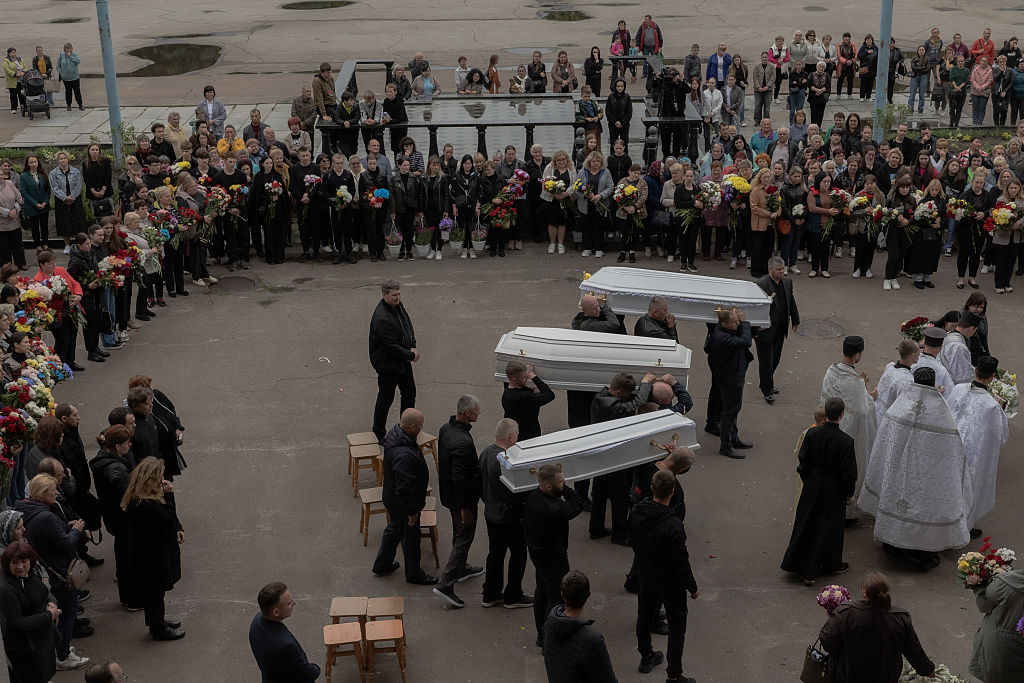
Men carry the coffins during the funeral ceremony of 17-year-old Roman Martyniuk, his 11-year-old sister Tamara Martyniuk, and 8-year-old brother Stanislav Martyniuk, who were killed by a Russian missile strike, at a town hall in Korostyshiv, Zhytomyr Oblast. Overnight on May 25, at least 13 Ukrainian civilians were killed in massive Russian strikes. (Roman Pilipey / AFP via Getty Images)
The Capitulation Demands: Putin’s True Price for “Peace”
Reuters’ bombshell revelation May 28 exposed Vladimir Putin’s actual negotiating position, stripping away diplomatic pretense to reveal demands that amount to Ukraine’s complete surrender and NATO’s dissolution. Three Russian sources familiar with Kremlin thinking confirmed what many suspected: Putin’s “peace” talks are merely a vehicle for achieving through diplomacy what he cannot secure through force.
The Russian demands read like a conqueror’s ultimatum: written pledges from major Western powers never to expand NATO eastward, effectively blocking Ukraine, Georgia, and Moldova from membership forever; Ukrainian neutrality enshrined in constitutional changes; comprehensive sanctions relief; resolution of frozen Russian sovereign assets; and nebulous “protections” for Russian speakers in Ukraine—the same pretext Moscow used to justify its 2022 invasion.
Most tellingly, Putin has “toughened his position” on territorial concessions, according to the Reuters sources, now demanding the entirety of four Ukrainian oblasts—Luhansk, Donetsk, Zaporizhzhia, and Kherson—including vast areas Russian forces have never occupied. The maximalist stance reveals the Kremlin’s calculation that time favors Russia, with one source stating Putin believes he can “fight for years” against any Western economic pressure.
The demands align perfectly with Russian officials’ public statements about addressing the war’s “root causes”—Kremlin doublespeak for dismantling the Western security architecture that has guaranteed European peace since 1945. Putin’s reference to 1990s verbal assurances about NATO expansion, never committed to writing and preceding the Soviet Union’s collapse, demonstrates Moscow’s intention to rewrite post-Cold War security arrangements entirely.
Deputy Security Council Chairman Dmitry Medvedev’s claim that 189,000 people joined Russian military units in 2025, including 175,000 arriving at military units and 14,000 joining volunteer formations, suggests Moscow believes it can sustain current casualty rates indefinitely. Ukrainian General Staff data indicating Russian daily losses averaging 1,140 in May versus Medvedev’s claimed recruitment rate of 1,285 per day reveals Putin’s calculation: as long as Russia can replace losses at roughly one-to-one ratios, gradual territorial gains will eventually force Western capitulation.
Ukraine’s Industrial Warfare: Striking the Heart of Russia’s War Machine
While Putin issued ultimatums, Ukraine delivered its response through precision strikes that may represent the largest single-day assault on Russian defense infrastructure since the war began. Ukrainian Security Service sources confirmed that long-range drones successfully penetrated Moscow’s air defenses to devastate multiple critical facilities, each strike precisely targeted to cripple specific components of Russia’s military-industrial complex.
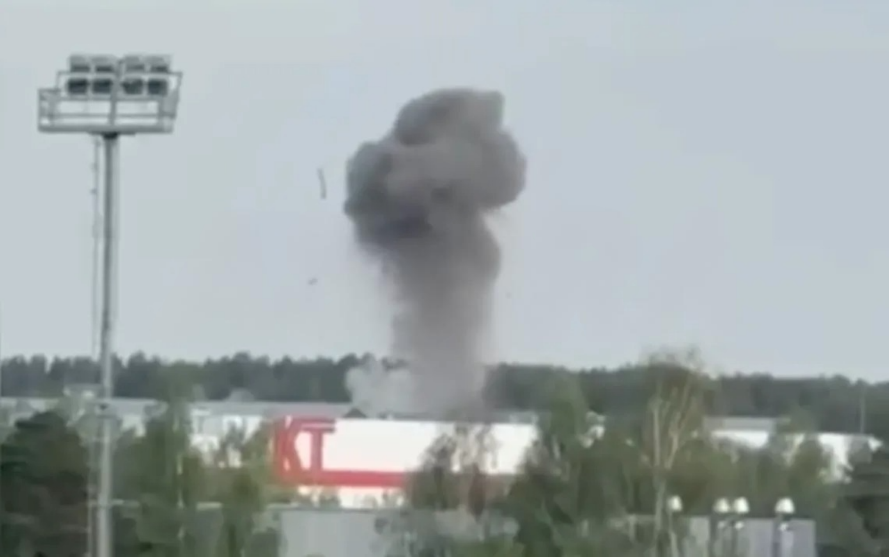
Drones allegedly attacked the town of Dubna in Moscow Oblast, Russia, overnight. (Astra)
The crown jewel of the assault was the Raduga enterprise in Dubna, Moscow Oblast, where Ukrainian drones bypassed Russian air defenses to strike assembly and outfitting workshops that remained ablaze as of 3 p.m. local time. The facility, located just 130 kilometers from Moscow, produces the Kh-101/555, Kh-69, and Kh-59MK cruise missiles that have terrorized Ukrainian cities for three years. Every workshop destroyed represents dozens of missiles that will never rain down on Ukrainian civilians.
Simultaneously, Ukrainian forces struck the Kronstadt drone facility in the same town, targeting production lines for Orion, Molniya, Grom, and Sirius drones that have provided Russian forces with reconnaissance and strike capabilities. The precision timing suggests sophisticated intelligence coordination, hitting multiple facilities before Russian air defenses could adapt to the threat vectors.
The assault extended to the Angstrem microelectronics plant in Zelenograd, one of Russia’s largest microchip manufacturing facilities and a critical hub for import substitution efforts. Ukrainian Center for Countering Disinformation Head Andriy Kovalenko noted the facility’s central role in Russia’s attempts to replace Western technology sanctions, making it a strategic target that degrades Moscow’s long-term military production capacity.
Russian air defense claims of shooting down 296 Ukrainian drones across multiple regions, if accurate, would mark one of the heaviest single-night drone attacks of the war. The scale suggests Ukraine has achieved mass production capabilities that allow sustained, large-scale operations against targets deep inside Russia, fundamentally altering the conflict’s strategic balance.
The success of these strikes, penetrating multiple layers of Russian air defense to hit precise targets, demonstrates Ukrainian technological advancement and intelligence superiority that Putin’s maximalist demands cannot address through negotiation.
Trump’s Two-Week Ultimatum: Testing Putin’s Sincerity
Donald Trump’s May 28 declaration that America would know within two weeks whether Vladimir Putin genuinely seeks peace marked a potential turning point in U.S. engagement with Moscow’s diplomatic theatrics. The president’s frustrated tone reflected growing White House impatience with Russian delays and continued attacks on Ukrainian cities during ostensible peace negotiations.
“We’re going to find out very soon. It’ll take about two weeks, or week and a half,” Trump told reporters, warning that if Moscow proves to be stalling, Washington would “respond a little bit differently.” The timeline coincides with Russia’s proposed June 2 Istanbul talks, creating concrete deadlines for Russian diplomatic performance.
Trump’s admission that “a couple of nights now where people were killed in the middle of what you would call a negotiation” revealed his disappointment with Putin’s approach to diplomacy. The comment referenced Russia’s May 24-26 aerial assault campaign, including the largest drone attack of the war, conducted while peace envoys supposedly prepared negotiating positions.
The president’s statement that he hasn’t imposed new sanctions because “if I think I’m close to getting a deal, I don’t want to screw it up” exposed the central tension in American policy: balancing pressure for negotiation against rewards for Russian bad faith. His claim to be “much tougher” than those he’s negotiating with rang hollow given his continued protection of Russia from congressional sanctions pressure.
CNN’s May 27 report that Trump is weighing new sanctions after Russia’s weekend assault suggests presidential patience may have limits. More than 80 senators backing bipartisan legislation for 500% tariffs on nations purchasing Russian energy and sweeping secondary sanctions creates domestic pressure that may force Trump’s hand regardless of negotiating preferences.
Special Envoy Steve Witkoff’s ongoing negotiations with the Russian side, praised by Trump as doing “a phenomenal job,” face the fundamental challenge that Putin’s leaked demands are completely unacceptable to any American administration. The two-week deadline may determine whether Trump acknowledges this reality or continues pursuing impossible compromises.
Germany’s €5 Billion Commitment: Aid Without Escalation
Chancellor Friedrich Merz’s unveiling of a €5 billion German military aid package during Volodymyr Zelensky’s Berlin visit demonstrated European commitment to Ukrainian defense while carefully avoiding the escalatory steps that could fundamentally alter the conflict’s trajectory. The massive financial commitment paired with continued Taurus missile restrictions epitomized Germany’s approach: maximum support within perceived red lines.
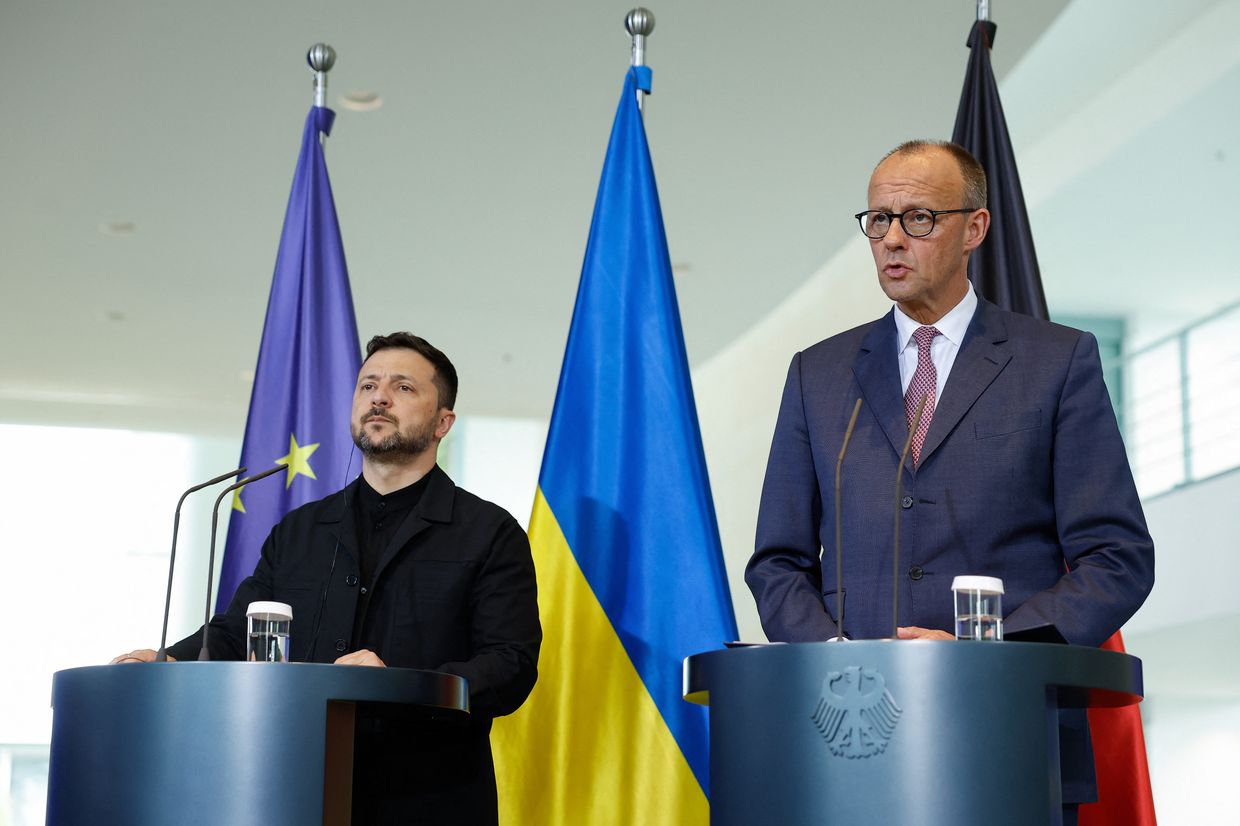
German Chancellor Friedrich Merz (R) and Ukrainian President Volodymyr Zelensky give a joint press conference at the Chancellery in Berlin. (Odd Andersen/AFP via Getty Images)
The package includes direct German investments in Ukraine’s defense industry, broader treaties between Kyiv and German arms manufacturers, and funding for long-range weapons production inside Ukraine. Defense Minister Boris Pistorius and his Ukrainian counterpart Rustem Umerov signed the accord at Berlin’s Bendlerblock, with officials promising significant system deliveries by year’s end and initial batches within weeks.
Merz’s commitment to finance Ukrainian production of long-range weapons and Starlink satellite operations addresses immediate military needs while building long-term industrial partnerships. The agreement establishes repair facilities in Ukraine and joint ventures between German and Ukrainian defense firms, creating sustainable support structures that outlast political cycles.
The chancellor’s statement that “there will be no restrictions on long-range weapons, Ukraine will be able to fully defend itself and also strike military targets outside the territory of Ukraine” referred to existing policy rather than new capabilities. His careful evasion of direct Taurus questions while promising expanded military support reflected Germany’s continued reluctance to provide weapons systems that could definitively alter battlefield dynamics.
Kremlin spokesman Dmitry Peskov’s predictable condemnation of the aid package as “provocation” that may hinder peace efforts ignored Russia’s own escalatory actions throughout supposed diplomatic engagement. Moscow’s rejection of aid that strengthens Ukrainian defense while simultaneously demanding Ukrainian capitulation revealed the fundamental contradictions in Russian negotiating positions.
The German package’s emphasis on joint production and technology transfer suggests Europe’s recognition that sustainable Ukrainian resistance requires industrial rather than merely military solutions, acknowledging that this conflict may continue for years regardless of current diplomatic efforts.
Russia’s Belarus Retreat: Military Capacity Limitations Exposed
Belarus’s announcement May 28 that it would scale back the September Zapad-2025 joint military exercise, cutting troop participation nearly in half and moving maneuvers away from western borders, provided stark evidence of Russia’s military overstretch in the Ukraine theater. Defense Minister Viktor Khrenin’s claim that the decision demonstrated Belarus’s “peace-loving position” barely concealed the reality that Russia lacks forces for major exercises while sustaining combat operations.
The reduction from approximately 13,000 to roughly 6,500 participants represents more than symbolic downsizing—it reflects fundamental force structure limitations that constrain Russian military options beyond Ukraine. Elements of formations that participated in previous Zapad exercises, including the 1st Guards Tank Army, 20th Combined Arms Army, and multiple VDV divisions, are currently fighting in Ukraine and unavailable for major training events.
The relocation of exercises away from NATO borders eliminates the intimidation value that traditionally justified Zapad events, transforming them from deterrent demonstrations into training necessities. The 2023 Zapad exercise was entirely canceled, very likely due to equipment and manpower requirements for the Ukraine war, making 2025’s reduced scope a continuation of war-imposed limitations rather than diplomatic gestures.
Belarusian officials’ framing of the reduction as de-escalation messaging aimed at Western audiences cannot obscure the underlying military reality: Russia lacks the force structure to simultaneously conduct large-scale training exercises and maintain current combat operations. The admission weakens Moscow’s negotiating position by revealing capacity constraints that limit Russian ability to open additional fronts or sustain prolonged high-intensity conflict.
The timing coincides with Ukrainian intelligence assessments that Russia has deployed 125,000 personnel to Sumy and Kharkiv oblast borders, suggesting Moscow must choose between exercises that maintain military readiness and operations that pursue immediate territorial gains. The choice reveals short-term thinking that prioritizes current advances over long-term military effectiveness.
Putin’s Ideological Mobilization: The Thousand-Year Narrative
Vladimir Putin’s May 28 Border Guards Day address revealed the Kremlin’s systematic effort to construct historical narratives that justify prolonged conflict while preparing Russian society for generational struggle against the West. His invocation of Russia’s “1,000-year history” since Ancient Rus’—the medieval state centered in Kyiv—represented a brazen appropriation of Ukrainian heritage to support imperial claims.
The reference to Kyivan Rus as the foundation of Russian statehood demonstrates Putin’s fundamental misunderstanding of medieval history or his willful distortion of it for propaganda purposes. His claim that Russian border guards developed “legendary traditions” throughout this millennium-long period ignores the historical reality that modern Russia emerged from Muscovite principalities that were peripheral to Kyivan civilization.
Putin’s justification for using Russian conscripts to defend Kursk Oblast through references to Second World War mythos and “Fatherland” defense revealed the Kremlin’s struggle to maintain public support for military policies that contradict previous promises. Repeated assurances that conscripts would not fight in Ukraine have been undermined by reality, forcing Putin to construct new justifications for their deployment.
The president’s emphasis on border guards who “repeatedly demonstrated themselves” in the Ukraine war while claiming confidence they will “continue to repel threats” suggested preparations for prolonged conflict along Russia’s periphery. His framing of current operations as defensive measures to protect the “Fatherland” inverted reality to portray Russian aggression as patriotic resistance.
The thousand-year historical narrative serves Putin’s broader effort to present current territorial disputes as existential struggles for Russian survival rather than imperial expansion campaigns. By claiming direct descent from Kyivan Rus, Moscow attempts to legitimize control over Ukrainian territory as historical restoration rather than foreign conquest.
International Justice: UN Confirms Systematic War Crimes
The United Nations Independent International Commission of Inquiry’s May 28 report confirming Russian forces committed crimes against humanity through systematic drone attacks on Kherson Oblast civilians provided authoritative documentation of Moscow’s terror campaign. The commission’s conclusion that attacks were “widespread, systematic, and part of a coordinated state policy” elevated individual war crimes to the level of systematic persecution.
The investigation documented nearly 150 civilian deaths and hundreds of injuries across Kherson city and 16 surrounding localities, with men, women, and children targeted while conducting daily activities. Russian drone operators used real-time video feeds to track and strike civilians, treating human hunting like “a video game” according to senior hospital officials.
The publication of attack videos on Telegram channels with “links to the perpetrating military units” provided direct evidence of command responsibility for war crimes. The commission’s finding that video dissemination “amounts to the war crime of outrages upon personal dignity” established additional criminal liability for systematic humiliation of victims.
The report’s conclusion that attacks aimed to “force the population of Kherson Province to leave the area” documented genocidal intent to permanently alter the region’s demographic composition. Telegram messages warning residents to “get out of the city before the leaves fall, you who are destined to die” provided direct evidence of terroristic objectives.
The commission’s inability to corroborate Ukrainian drone attacks on civilians due to Russian non-cooperation contrasted sharply with extensive documentation of Russian crimes, undermining Moscow’s false equivalency claims. The systematic nature of Russian attacks, coordinated across multiple platforms and documented through official channels, distinguished them from isolated incidents of collateral damage.
Ukrainian Children Rescued: Eleven More Return Home
Presidential advisor Daria Zarivna’s announcement May 28 that eleven more Ukrainian children had been rescued from Russian-occupied territories through the “Bring Kids Back UA” initiative provided a rare bright moment amid systematic documentation of Russian crimes against civilians. The rescued children’s stories—including an Azovstal defender’s daughter and a nearly-conscripted teenager—illustrated the human stakes of Russia’s deportation campaign.
The girl whose mother and brother defended Azovstal steel plant spent more than three years separated from family members held in Russian captivity, representing thousands of similar cases where Russian forces have deliberately separated Ukrainian families. Her reunion symbolized both the success of rescue efforts and the scale of ongoing family destruction caused by Russian policies.
The teenage boy who had been orphaned, kidnapped from school, held in a basement, tortured, and nearly conscripted into the Russian army days before his 18th birthday embodied the systematic nature of Russian efforts to erase Ukrainian identity through forced assimilation. His rescue demonstrated Ukrainian determination to reclaim its future generation from Russian indoctrination programs.
The operation’s success amid ongoing conflict reflected sophisticated intelligence cooperation and diplomatic coordination required to extract children from hostile territory. Each rescue represents multiple intelligence sources, diplomatic contacts, and operational risks undertaken to restore Ukrainian families torn apart by Russian aggression.
Since the invasion began, Ukraine has identified over 19,500 children forcibly deported to Russia, Belarus, or occupied territories, with only around 1,300 returned to Ukrainian-controlled areas. The massive disparity between deportations and returns illustrates the scale of Russian crimes against Ukrainian childhood and the challenges facing rescue efforts.
Turkish Mediation: June 2 Istanbul Talks Proposed
Russian Foreign Minister Sergei Lavrov’s May 28 announcement that Moscow proposed June 2 for the next round of Istanbul talks represented Russia’s attempt to maintain diplomatic momentum while avoiding concrete concessions. His claim that Russia had “promptly drafted a corresponding memorandum” contrasted with the twelve-day delay since promising immediate delivery, revealing Moscow’s continued stalling tactics.
Ukrainian Defense Minister Rustem Umerov’s response that Ukraine had delivered its document while still awaiting Russia’s version highlighted the asymmetric nature of current diplomatic engagement. His statement crediting pressure from Trump, European leaders, and Zelensky for compelling Moscow to complete its draft demonstrated how Russian diplomatic behavior responds only to sustained pressure.
Lavrov’s description of the memorandum as addressing “root causes of the crisis” confirmed that Russia’s June 2 presentation would rehash maximalist demands rather than offer genuine compromise positions. The “root causes” formulation has consistently served as Russian code for NATO dissolution and Ukrainian capitulation, suggesting talks will fail unless Ukraine accepts impossible terms.
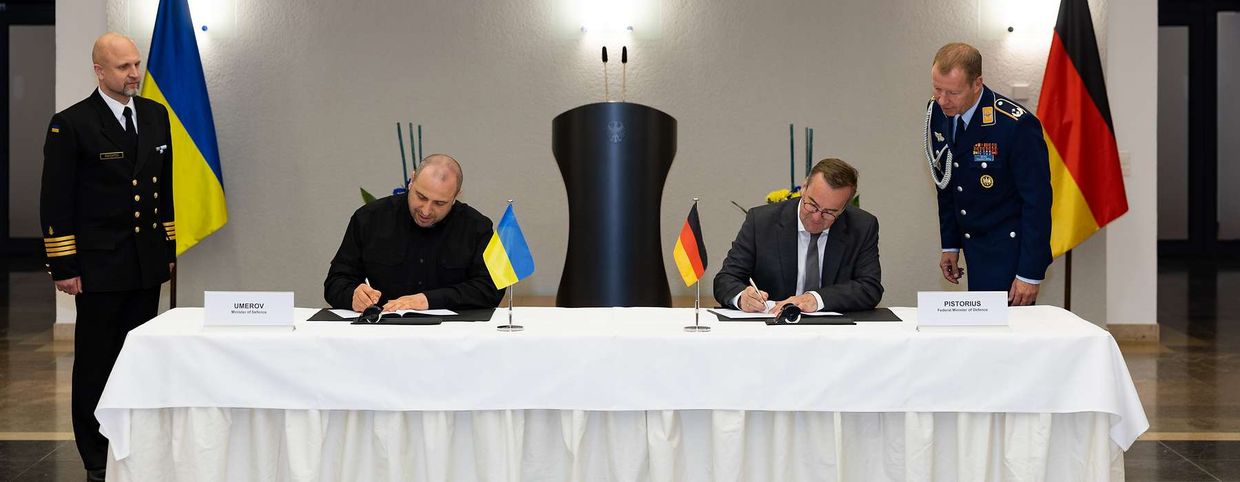
Ukrainian Defence Minister Rustem Umerov and German Defence Minister Boris Pistorius sign an agreement to finance the production of advanced Ukrainian-made weaponry in Berlin, Germany. (German Defense Ministry)
Turkish Foreign Minister Hakan Fidan’s expected visit to Ukraine following his Moscow meetings positioned Ankara as a crucial intermediary, though Turkey’s ability to bridge fundamentally incompatible positions remains questionable. The proposed Istanbul venue offers neutral ground that neither side can reject without appearing obstructionist, but venues cannot overcome substantive disagreements.
The June 2 timeline coincides with Trump’s two-week ultimatum for assessing Putin’s sincerity, creating pressure for Russian diplomatic performance that Moscow may be unable to deliver. If Russia presents maximalist demands disguised as peace proposals, the talks’ failure could trigger American sanctions responses that Putin has sought to avoid.
Azerbaijan’s Arms Buildup: 1,279 Azov Fighters Still Captive
Ukrainian Coordination Headquarters for Prisoner Treatment revealed May 28 that 1,279 of approximately 2,500 Azov fighters held in Russian captivity have been returned since being captured, including 455 from the Azov Brigade specifically. The statistic provided concrete evidence of Ukrainian efforts to secure defenders’ release while highlighting the enormous numbers still held in Russian detention.
Deputy head Andrii Yusov’s acknowledgment that “no statistics can replace loved ones for individual families” responded to social media criticism following the May 25 1,000-for-1,000 prisoner exchange that failed to include many Azov fighters. The criticism reflected broader Ukrainian society’s commitment to the Mariupol defenders who bought crucial time during the war’s initial phase.
Colonel Denys Prokopenko’s description of the recent exchange as a “mockery” due to the absence of Azov Brigade members highlighted ongoing tensions between exchange priorities and public expectations. The Azovstal defenders’ symbolic importance to Ukrainian resistance creates political pressure that complicates prisoner negotiation calculations.
The revelation that over 1,200 Azov fighters remain in Russian captivity despite numerous exchanges demonstrates Moscow’s systematic retention of Ukraine’s most symbolically important prisoners. Russian forces treat Azov fighters as high-value hostages whose release requires maximum Ukrainian concessions, reflecting the political rather than purely humanitarian nature of prisoner exchanges.
Ukraine’s advocacy for “all-for-all” exchanges versus Russia’s selective release policies reveals fundamental differences in approach to prisoner treatment. Moscow’s refusal to embrace comprehensive exchanges reflects its understanding that prisoner leverage provides continuing influence over Ukrainian decision-making processes.
German-Ukrainian Industrial Partnership: Long-Range Production Alliance
The signing of a memorandum on joint purchase of Ukrainian-produced “long-range fires” announced by Chancellor Merz represented a significant evolution in German-Ukrainian defense cooperation beyond simple weapons transfers to industrial partnership. The agreement creates sustainable production relationships that could outlast political changes in either country.
Merz’s commitment to finance Starlink operations in Ukraine addressed critical communications infrastructure needs that underpin Ukrainian military effectiveness. The satellite system’s importance for coordination, intelligence, and command functions makes German financial support a force multiplier that enhances all Ukrainian military capabilities.
The chancellor’s statement that “there will be no restrictions on long-range weapons” while avoiding specific Taurus commitments reflected Germany’s carefully calibrated approach to escalation management. By supporting Ukrainian production rather than providing German systems, Berlin attempts to maintain influence over escalation dynamics while strengthening Ukrainian capabilities.
The memorandum’s provision for production in either Ukraine or Germany creates flexibility that addresses both countries’ industrial capacities and security concerns. Joint production arrangements distribute risks while building integrated defense industrial relationships that strengthen both partners’ long-term security.
Defense Minister Pistorius and his Ukrainian counterpart’s signing ceremony at the Bendlerblock symbolized Germany’s commitment to Ukrainian defense while maintaining careful boundaries around the most escalatory weapons systems. The approach reflects European attempts to balance maximum support with perceived escalation risks.
Expanding International Support: Drone Coalition Grows
Latvia’s announcement that Turkey and Belgium would join the international Drone Coalition supporting Ukraine brought the alliance to 20 member states with €2.75 billion allocated for 2025. Defense Minister Andris Spruds’ emphasis on strengthening defense industries across Latvia, the EU, and NATO demonstrated the coalition’s dual benefits of supporting Ukraine while building Western military capabilities.
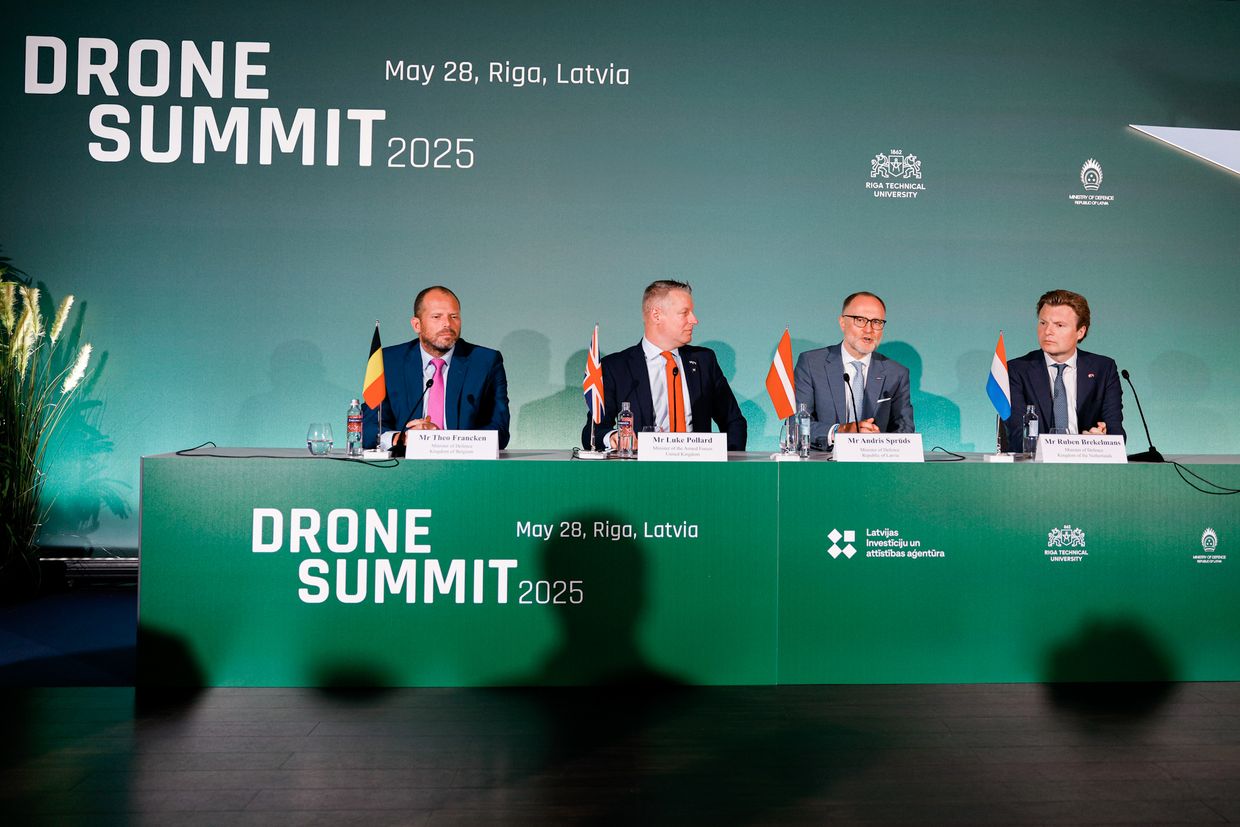
Drone Summit held in Riga, Latvia. (Defense Ministry of Latvia)
The coalition’s total commitment of €4.5 billion over two years, including €1.8 billion delivered in 2024, represents substantial resources dedicated specifically to unmanned systems that have proven crucial for Ukrainian operations. The focused approach allows specialized expertise development and economies of scale that benefit all participants.
Turkey’s inclusion despite its complex relationship with both NATO allies and Russia reflects Ankara’s balancing approach to the conflict while demonstrating commitment to Ukrainian defense capabilities. Belgian participation completes Western European representation in the coalition, suggesting broad consensus on drone warfare’s importance for future conflicts.
The coalition complements Ukraine’s domestic “Drone Line” project launched in February, creating integrated approaches that combine international support with Ukrainian innovation. The partnership model allows technology transfer and industrial cooperation that builds long-term capabilities rather than simple aid dependence.
Latvia and the UK’s co-leadership of the coalition demonstrates smaller nations’ ability to lead specialized military initiatives that serve broader alliance interests. The model could be replicated for other military specializations, creating flexible coalition structures that adapt to evolving warfare requirements.
EU’s Black Sea Strategy: Countering Russian Maritime Threats
EU High Representative Kaja Kallas unveiled May 28 a comprehensive “Strategic Approach to the Black Sea Region” designed to counter Russian threats and strengthen European security in waters increasingly dominated by Moscow’s aggressive policies. The strategy encompasses early warning systems, infrastructure protection, and enhanced cooperation with regional partners from Ukraine to Turkey.
The centerpiece proposal—a Black Sea Maritime Security Hub—would provide real-time monitoring from space to seabed, including mine clearance capabilities and protection for offshore energy platforms and subsea cables. Kallas described the hub as essential for detecting Russian airspace violations and attacks on shipping lanes that have disrupted regional commerce and threatened European energy security.
The strategy’s focus on upgrading regional transport networks, including ports, roads, railways, and airports, addresses NATO’s longstanding challenge of rapidly deploying heavy military equipment to Eastern Europe. Enhanced mobility corridors would allow troops to reach threatened areas faster while reinforcing alliance deterrence against Russian aggression.
The anti-hybrid warfare components target Russian disinformation campaigns and cyberattacks that have plagued Black Sea nations for years. EU investments in artificial intelligence to counter false narratives, media literacy programs, and fact-checking networks represent systematic approaches to information warfare that complements military deterrence efforts.
Turkey’s potential role in assuring safe passage and mine clearance in case of ceasefire demonstrates Ankara’s unique position as a NATO member maintaining relations with both Russia and Ukraine. The strategy acknowledges Turkey as a “vital partner and candidate country” while leveraging its geographic control over Black Sea access points.
Russian Recruitment Claims: Medvedev’s Numbers Game
Deputy Security Council Chairman Dmitry Medvedev’s May 28 claim that 189,000 people joined Russian military formations in 2025—175,000 at military units and 14,000 in volunteer formations—represented Moscow’s attempt to project strength while obscuring mounting manpower challenges. The figures, if accurate, suggest daily recruitment rates of 1,285 personnel, barely exceeding Ukrainian assessments of Russian daily losses.
Ukrainian General Staff data indicating Russian casualties averaged 1,140 per day in May, down from 1,550 in January, suggests either improving Russian tactics or Ukrainian intelligence gaps in casualty assessment. Medvedev’s recruitment claims of roughly one-to-one replacement ratios indicate Russia can sustain current loss rates indefinitely, supporting Putin’s strategy of gradual territorial gains through prolonged attrition.
The emphasis on “voluntary” recruitment rather than mobilization reflects Kremlin sensitivity to public opinion about conscription expansion. Putin’s May 13 claim that 50,000-60,000 people join monthly—higher than Medvedev’s figures—reveals inconsistent messaging that suggests either coordination failures or deliberate information manipulation.
The recruitment statistics support Reuters’ reporting that Putin believes Russia can “fight for years” against Western economic pressure, viewing time as favoring Moscow’s position. If Russia can indeed replace losses at sustainable rates while gradually advancing, Putin’s maximalist negotiating demands become more comprehensible as expressions of confidence rather than desperation.
However, the quality of recruits, their training levels, and unit cohesion metrics remain unreported, suggesting potential weaknesses that raw numbers cannot address. Russia’s ability to convert recruitment into effective combat power depends on factors beyond simple personnel replacement that Medvedev’s statistics do not capture.
Zelensky’s G7 Commitment: June Summit Participation Confirmed
President Volodymyr Zelensky’s May 28 confirmation that he would attend the Group of Seven summit in Canada positioned Ukraine prominently on the international stage during a critical period of diplomatic maneuvering. His presence at the June 15-17 Kananaskis County gathering ensures Ukrainian perspectives directly influence discussions among the world’s leading democracies.
The timing coincides with Russia’s proposed June 2 Istanbul talks and Trump’s two-week deadline for assessing Putin’s sincerity, creating a compressed diplomatic schedule where G7 decisions could directly impact peace negotiation dynamics. Zelensky’s ability to address allied leaders face-to-face provides Ukraine crucial influence over Western responses to Russian diplomatic positions.
Canadian Prime Minister Mark Carney’s March invitation, issued shortly after taking office, demonstrated continuity in Canadian support despite domestic political changes. The summit represents Carney’s first major international gathering and Trump’s return to G7 diplomacy after his previous presidency’s contentious allied relationships.
The agenda’s focus on Ukraine support, global economic stability, digital transformation, and climate change allows Zelensky to connect Ukrainian resistance to broader democratic values and international stability. His presence transforms discussions from abstract policy debates to concrete commitments affecting ongoing conflict.
NATO Secretary General Mark Rutte’s willingness to include Ukraine at the June 24-25 alliance summit creates additional opportunities for Ukrainian diplomatic engagement during the crucial period when peace talks may determine the war’s trajectory. The coordination between G7 and NATO events suggests allied recognition that Ukrainian participation strengthens both organizations’ credibility.
Systematic War Crimes: UN Documents Russian Terror Campaign
The UN Independent International Commission of Inquiry’s May 28 report provided authoritative documentation that Russian forces committed crimes against humanity through systematic drone attacks targeting Kherson Oblast civilians. The commission’s conclusion that attacks were “widespread, systematic, and part of a coordinated state policy” elevated individual incidents to the level of state-sponsored terrorism.
The investigation documented 300 videos, 600 Telegram posts, and 91 interviews revealing a months-long pattern of deliberately targeting civilians with drones operated from the left bank of the Dnipro River. Russian operators used real-time video feeds to hunt individual civilians, with senior hospital officials describing the attacks as treating human lives like “a video game.”
The publication of killing videos on Russian military Telegram channels with “thousands of followers” provided direct evidence of command responsibility and systematic glorification of war crimes. The commission’s finding that video dissemination constitutes “outrages upon personal dignity” established additional criminal liability beyond the underlying attacks.
Telegram messages explicitly threatening the population—”Get out of the city before the leaves fall, you who are destined to die”—documented genocidal intent to permanently depopulate the region through terror. The coordination between physical attacks, video documentation, and psychological warfare revealed sophisticated campaigns designed to maximize civilian trauma.
The commission’s inability to corroborate Ukrainian attacks on Russian civilians due to Moscow’s non-cooperation contrasted sharply with extensive documentation of systematic Russian crimes. The disparity undermined Russian false equivalency claims while highlighting Moscow’s deliberate obstruction of international accountability mechanisms.
Military Casualties Across Ukraine: Daily Toll Continues
Russian attacks across Ukrainian regions killed at least one civilian and injured 46 others, including children, during the May 27-28 period, according to regional authorities. The casualties, distributed across multiple oblasts from Kharkiv to Zaporizhzhia, illustrated the geographic scope of Russian targeting and the continuing threat to civilian populations.
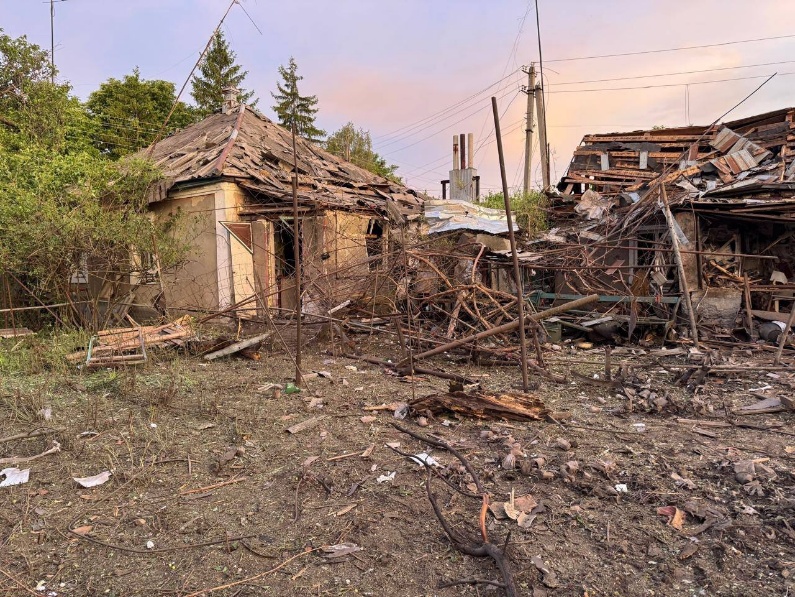
The aftermath of Russian attacks against Kharkiv Oblast, Ukraine. (Governor Oleh Syniehubov/Telegram)
In Kharkiv Oblast, Russian strikes killed an 85-year-old man and injured nine others, including a 4-year-old girl, while damaging over 70 houses, 12 apartment buildings, a school, shops, and warehouses. The targeting of residential areas and civilian infrastructure demonstrated continued Russian adherence to terror bombing tactics designed to break Ukrainian morale.
Kherson Oblast suffered 13 injuries from Russian attacks, continuing the systematic targeting documented in the UN commission’s crimes against humanity findings. The casualties represent daily additions to the hundreds already documented in the region’s months-long terror campaign against civilians.
Attacks in Dnipropetrovsk, Donetsk, Kirovohrad, Mykolaiv, Sumy, and Zaporizhzhia oblasts injured dozens more civilians, including a 7-year-old girl and 17-year-old boy, demonstrating Russian forces’ continued targeting of children despite international condemnation. The geographic distribution suggests coordinated campaigns rather than isolated incidents.
The casualty reports coincided with Ukrainian Air Force data showing Russia launched five Iskander ballistic missiles and 88 Shahed drones, with Ukrainian defenses intercepting 34 drones while electronic warfare systems neutralized 37 others. The successful interception rates highlight both Ukrainian defensive capabilities and the massive scale of Russian attacks required to overwhelm them.
German-American Coordination: Unified Approach to Russian Pressure
German Foreign Minister Johann Wadephul and Secretary of State Marco Rubio’s May 28 Washington meeting established coordinated approaches to compelling Putin toward “serious negotiations” through sustained pressure rather than concessions. Their agreement to “closely coordinate next steps” represented alliance unity despite Trump’s previous reluctance to escalate economic pressure on Moscow.
Wadephul’s emphasis that “Putin continues its attacks on Ukraine—despite the peace diplomacy of recent weeks” acknowledged the fundamental contradiction in Russian behavior: claiming interest in peace while intensifying military operations. His warning of “further sanctions if Russia does not budge” aligned German and American approaches around pressure-based diplomacy.
The German minister’s support for NATO Secretary General Jens Stoltenberg’s proposal to boost combined defense spending to 5% of GDP—3.5% for defense and 1.5% for infrastructure—demonstrated European commitment to burden-sharing that Trump has demanded. The spending commitment addresses American concerns about European free-riding while strengthening collective deterrence.
Rubio’s welcoming of “Germany’s commitment to increasing its defense spending” during his 54th birthday celebration reflected warming American-German relations after years of tension over defense contributions. The personal gesture of a Miami Dolphins poster gift symbolized restored friendship that strengthens alliance coordination against Russian threats.
The meeting preceded planned visits by Chancellor Merz to Washington, creating multiple diplomatic channels for coordinating responses to Russian negotiating positions. The sustained engagement reflects both countries’ recognition that allied unity remains essential for compelling meaningful Russian diplomatic behavior.
The Week Ahead: June 2 Moment of Truth
As May 28 concluded with Russia’s impossible demands exposed and Ukraine’s industrial strikes demonstrating growing capabilities, the June 2 Istanbul talks loom as a potential watershed moment. Trump’s two-week timeline for assessing Putin’s sincerity coincides perfectly with Russia’s proposed negotiation date, creating pressure for definitive answers to fundamental questions about Moscow’s commitment to meaningful diplomacy.
Putin’s leaked demands for NATO’s effective dissolution, Ukraine’s capitulation, and sanctions relief reveal the chasm between Russian maximalism and any acceptable Western position. If Moscow presents these terms as serious negotiating positions, the talks’ failure becomes inevitable, potentially triggering the American sanctions responses that Putin has desperately sought to avoid.
Ukraine’s successful strikes on Russian defense infrastructure demonstrate growing capabilities that complicate Putin’s calculation that time favors Moscow. Every cruise missile factory destroyed, every drone facility damaged, every microchip plant disabled degrades Russia’s ability to sustain prolonged high-intensity conflict against increasingly capable Ukrainian forces.
The coming week will test whether diplomatic theater can continue masking fundamental disagreements or whether the pretense of negotiation finally collapses under the weight of irreconcilable positions. Putin’s choice between impossible demands and genuine compromise will determine whether June 2 represents breakthrough or breakdown in efforts to end Europe’s largest conflict since 1945.
